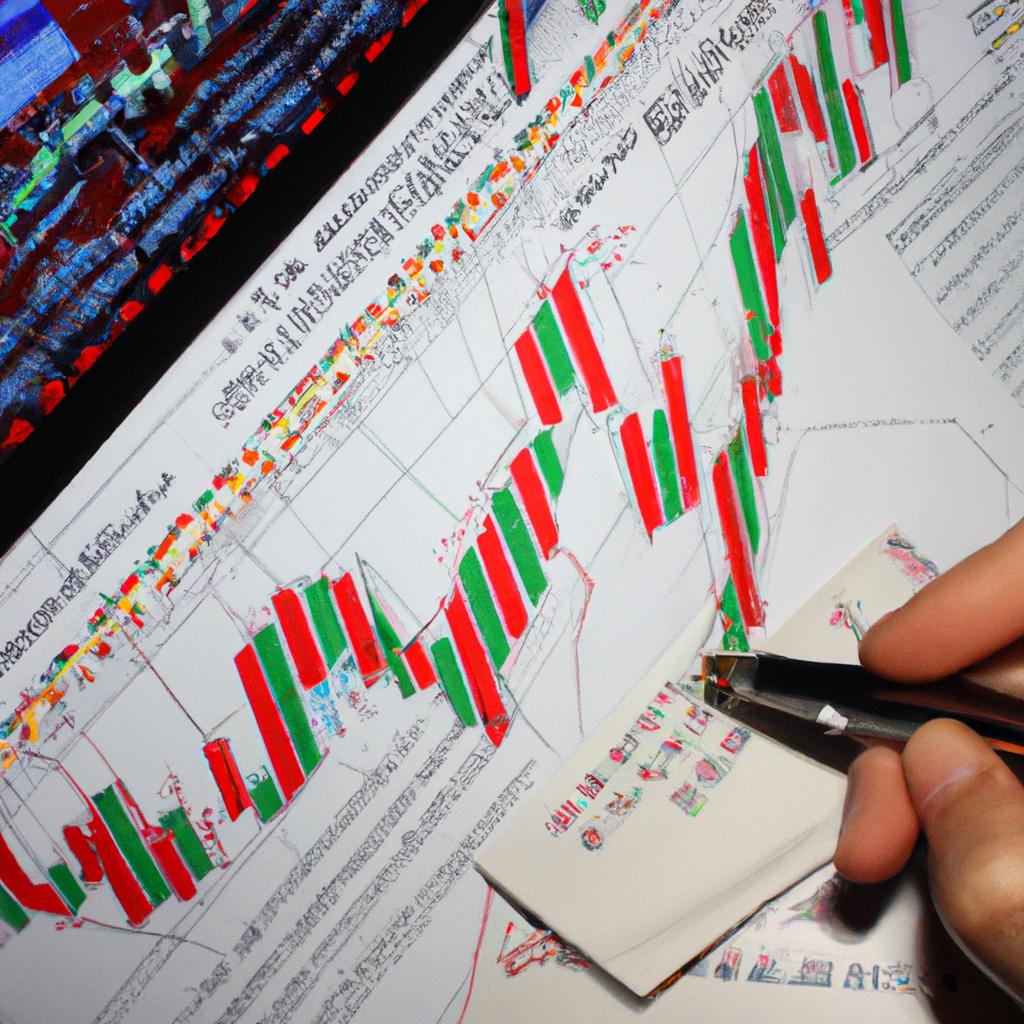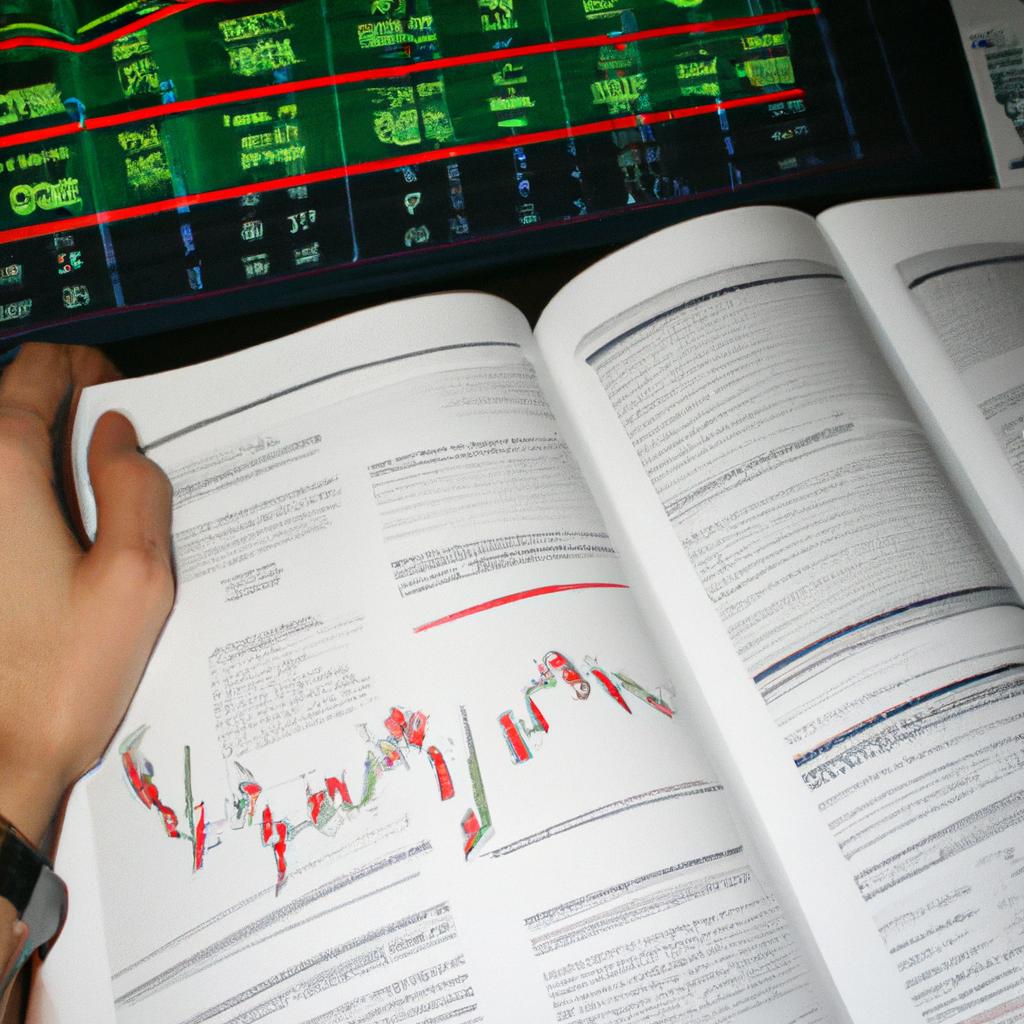Supply and Demand Dynamics: A Guide to Investing in Commodities

The phenomenon of supply and demand dynamics plays a crucial role in the world of investing, particularly when it comes to commodities. Understanding how these forces interact can provide valuable insights for investors seeking to navigate this complex market. For instance, let us consider the case of gold—a highly sought-after commodity known for its intrinsic value and diverse range of uses. By examining the interplay between supply and demand factors in the gold market, we can uncover key patterns that inform investment decisions.
Supply and demand dynamics refer to the relationship between the availability of a particular product or resource (supply) and the desire or need for that product (demand). These two fundamental forces determine price levels and ultimately shape market behavior. In the context of commodities such as metals, agricultural products, or energy resources, understanding supply and demand dynamics is essential due to their inherent volatility. Fluctuations in global economic conditions, geopolitical events, weather patterns, and technological advancements all impact both sides of this equation, creating an intricate web of influences on prices. Consequently, gaining a comprehensive understanding of supply and demand dynamics becomes crucial for successful investments in commodities.
Understanding Supply and Demand
Supply and demand dynamics play a crucial role in shaping the prices of commodities. To comprehend this relationship, let us consider the example of coffee production. Imagine a scenario where there is an unexpected drought in Brazil, one of the largest coffee-producing countries. As a result, the supply of coffee decreases significantly due to crop failure. At the same time, consumer demand for coffee remains constant or even increases as people continue their daily caffeine fix. This imbalance between supply and demand causes coffee prices to rise.
To better understand how supply and demand interact, we can examine several key factors:
-
Population Growth: With an increasing global population, the demand for essential commodities like food, energy, and metals continues to grow steadily. The rising number of consumers puts upward pressure on prices as it strains existing supplies.
-
Economic Development: As developing economies experience growth and industrialization, they require more resources to fuel their expansion. This heightened demand impacts commodity markets by driving up prices due to increased consumption.
-
Technological Advancements: Innovations often lead to changes in both supply and demand. For instance, advancements in renewable energy technologies have reduced the reliance on fossil fuels while simultaneously creating new demands for rare earth metals used in green technologies.
-
Geopolitical Factors: Political instability or conflicts in major producing regions can disrupt supply chains and create uncertainties around future availability. These disruptions influence market sentiment and may cause price volatility.
Table 1 provides a visual representation of these factors highlighting their impact on supply and demand dynamics:
| Factor | Impact on Supply | Impact on Demand |
|---|---|---|
| Population Growth | Increase | Increase |
| Economic Development | Varies | Increase |
| Technological Advancements | Increase/Decrease | Increase/Decrease |
| Geopolitical Factors | Decrease | Varies |
Understanding the intricate relationship between supply and demand is essential for investors looking to navigate commodity markets. By examining these factors, one can gain valuable insights into how price fluctuations are influenced.
Transitioning seamlessly into the subsequent section about “Factors Influencing Price Fluctuations,” let us now delve deeper into other significant aspects affecting commodities’ market dynamics.
Factors Influencing Price Fluctuations
Transitioning from our previous exploration of supply and demand dynamics, it is crucial to delve into the various factors that significantly influence price fluctuations in commodities. To illustrate this point, let’s consider the hypothetical case of wheat production in a major agricultural region.
-
Weather Conditions:
One primary determinant of commodity prices is weather conditions. Extreme weather events such as droughts or floods can have a profound impact on crop yields. For instance, if a severe drought were to strike the aforementioned hypothetical wheat-producing region, resulting in reduced harvests, the limited supply would drive up prices due to increased scarcity. -
Geopolitical Unrest:
Geopolitical unrest also plays a critical role in shaping commodity prices. Political instability or conflicts in key regions can disrupt production and transportation systems, leading to supply disruptions and subsequent price increases. An example could be an armed conflict occurring near a significant oil-producing country, causing concerns about potential disruptions to oil supplies and consequently driving up crude oil prices worldwide. -
Economic Growth:
The state of global economic growth directly affects the demand for commodities. During periods of robust economic expansion, there tends to be higher consumption rates across industries like construction and manufacturing which rely heavily on raw materials. This increased demand places upward pressure on prices. Conversely, during times of economic downturns or recessions when industrial activities contract, demand decreases correspondingly, leading to lower commodity prices. -
Currency Exchange Rates:
Currency exchange rates can be another influential factor affecting commodity prices. When the value of one currency weakens against others, it becomes more expensive for holders of that currency to purchase commodities priced in other currencies. As a result, decreased purchasing power may lead to diminished demand and potentially lower prices.
To further understand these influencing factors at play within commodities markets, we present the following table:
| Factor | Influence on Prices |
|---|---|
| Weather Conditions | Increased Scarcity |
| Geopolitical Unrest | Supply Disruptions |
| Economic Growth | Higher Demand |
| Currency Exchange Rates | Diminished Purchasing Power |
As we explore the intricate interplay between supply, demand, and these significant factors influencing price fluctuations in commodities, it becomes evident that a multifaceted approach is necessary to navigate this complex market landscape successfully.
Transitioning into our subsequent section on “The Role of Speculation in Commodities,” we will delve into how speculative activities can further impact prices within these markets.
The Role of Speculation in Commodities
Continuation from the previous section:
Factors such as supply and demand play a crucial role in determining price fluctuations in commodities. Understanding these dynamics is essential for investors seeking to make informed decisions. To further explore this topic, let us delve into the role of speculation in influencing commodity prices.
Speculation, driven by anticipation of future market conditions or events, can significantly impact commodity prices. For instance, consider the case study of crude oil prices between 2007 and 2008. During this period, concerns over geopolitical tensions and potential disruptions in oil supplies intensified speculative activities. As a result, the price of crude oil skyrocketed to unprecedented levels. This example highlights how speculation can amplify price movements beyond what would be expected based solely on fundamental factors.
To better comprehend the influence of speculation on commodity markets, it is important to consider several key aspects:
-
Market Sentiment:
- Investor sentiment can drive increased buying or selling activity.
- Positive sentiments may lead to higher demand and subsequently rising prices.
- Conversely, negative sentiments can trigger selling pressure and cause prices to decline.
-
Liquidity:
- High liquidity attracts more participants to the market, potentially increasing speculative trading volumes.
- Increased trading volume often leads to greater price volatility as speculators enter and exit positions rapidly.
-
Economic Indicators:
- Macroeconomic indicators such as GDP growth rates or inflation can shape investor expectations about future demand for commodities.
- Speculators closely monitor these indicators when making investment decisions that involve predicting future price movements.
-
Regulatory Measures:
- Government regulations imposed on speculative activities within commodity markets can directly impact pricing dynamics.
- Stricter regulations tend to limit excessive speculation, which helps stabilize prices and reduce volatility.
Understanding these factors can empower investors to navigate the complex interplay between speculation and commodity prices. By keeping a close eye on market sentiment, liquidity conditions, economic indicators, and regulatory measures, they can make more informed decisions when investing in commodities.
Transitioning into the subsequent section:
Having explored the influence of speculation on commodity pricing dynamics, it is essential to now examine its broader implications within the context of global economic forces. The next section will delve into how shifts in the global economy impact supply and demand dynamics for various commodities.
Global Economic Impact on Supply and Demand
Supply and Demand Dynamics: A Guide to Investing in Commodities
The Role of Speculation in Commodities has shed light on the significant influence that speculative activities can have on commodity prices. However, it is crucial to recognize that global economic factors also play a pivotal role in shaping supply and demand dynamics. Understanding these factors is essential for investors seeking profitable opportunities in commodities markets.
One real-life example illustrating the impact of global economic factors on supply and demand is the 2008 financial crisis. As the crisis unfolded, consumer confidence plummeted, leading to decreased spending across various industries. This reduction in consumer purchasing power resulted in lower demand for commodities such as oil, copper, and steel. Simultaneously, many businesses scaled back their production levels or even halted operations entirely, further exacerbating the decline in demand.
To comprehend how global economic conditions affect supply and demand dynamics in commodities markets, consider the following key points:
- Economic growth rates: Strong economic growth typically leads to an increase in overall consumption patterns, driving up demand for commodities.
- Exchange rates: Fluctuations in currency exchange rates can significantly impact international trade flows and consequently influence both supply and demand for commodities.
- Government policies: Regulatory measures implemented by governments often aim to stabilize or stimulate economies. These policies can directly impact specific sectors within commodity markets through changes in taxes, subsidies, or import/export restrictions.
- Geopolitical events: Political instability or conflicts can disrupt commodity supplies from certain regions, causing potential shortages and affecting market prices.
Table: Examples of Global Economic Factors Impacting Supply and Demand Dynamics
| Economic Factor | Effect on Supply | Effect on Demand |
|---|---|---|
| Economic Growth | Potential increase | Potential increase |
| Exchange Rates | Imported goods become more costly | Exports become cheaper |
| Government Policies | Subsidies promote domestic output | Taxes decrease spending |
| Geopolitical Events | Production disruptions | Uncertainty reduces demand |
Understanding the intricate relationship between global economic factors and supply and demand dynamics is crucial for investors navigating commodities markets. By staying informed about macroeconomic trends, geopolitical developments, and government policies, investors can make more informed decisions based on anticipated changes in commodity prices.
Transitioning into the subsequent section on “Supply Chain Disruptions and their Effects,” it becomes evident that these global economic factors are not the only elements influencing commodities markets. Supply chain disruptions caused by various events also play a significant role in shaping market conditions and presenting both challenges and opportunities for investors.
Supply Chain Disruptions and their Effects
Transitioning from the previous section, where we explored the global economic impact on supply and demand dynamics, we now turn our attention to another crucial aspect of understanding commodities investment: supply chain disruptions and their effects. To illustrate this concept, let us consider a hypothetical case study involving the production and distribution of crude oil.
Imagine a scenario where political tensions between two major oil-producing countries escalate rapidly. As a result, one country imposes trade restrictions on the other, leading to a significant decrease in the global supply of crude oil. This disruption in the supply chain can have far-reaching consequences for both producers and consumers worldwide.
When analyzing the effects of such disruptions, it is essential to consider various factors:
- Price volatility: A sudden reduction in supply can cause prices to spike as market participants scramble to secure available resources.
- Market speculation: Uncertainty surrounding future supplies may lead to increased speculative activity, further exacerbating price fluctuations.
- Production shifts: In response to disrupted supply chains, some producers might redirect their efforts towards alternative sources or explore technological advancements.
- Regional impacts: The magnitude of these disruptions will vary across regions based on factors like proximity to affected areas and existing inventories.
To provide a comprehensive overview of potential outcomes resulting from supply chain disruptions, refer to Table 1 below:
| Potential Effects | Positive Impact | Negative Impact |
|---|---|---|
| Short-term price hikes | Increased profitability | Higher costs for consumers |
| Long-term infrastructure investments | Job creation | Capital expenditures |
| Search for alternative suppliers | Diversification | Higher transportation costs |
| Enhanced risk management strategies | Improved resilience | Operational challenges |
Table 1: Potential Effects of Supply Chain Disruptions on Commodities Markets
In light of these considerations, investors must remain vigilant when assessing commodity markets prone to such disruptions. By understanding the potential effects and incorporating risk management strategies, they can navigate these challenging situations successfully. In the upcoming section on “Risk Management Strategies for Commodities,” we will explore specific approaches to mitigate risks associated with supply chain disruptions and other market uncertainties.
Risk Management Strategies for Commodities
In the previous section, we explored the crucial role of supply chain disruptions in understanding the dynamics of commodities. Now, let us delve deeper into the various effects that these disruptions can have on commodity markets.
To illustrate this, let’s consider a hypothetical case study involving a major coffee-producing country experiencing adverse weather conditions. Due to prolonged droughts, coffee crops are significantly impacted, leading to a decrease in coffee production by 30%. This disruption in the supply chain results in reduced availability of coffee beans for exporters and roasters worldwide.
The effects of such supply chain disruptions are far-reaching and can be summarized as follows:
- Price Volatility: Supply chain disruptions often lead to price volatility as demand remains constant or even increases while supply diminishes. In our example, the decreased availability of coffee beans will result in higher prices for consumers and buyers alike.
- Market Speculation: The uncertainty caused by supply chain disruptions can attract speculators who seek to profit from anticipated price movements. As speculation intensifies, it may further exacerbate price fluctuations and create additional challenges for market participants.
- Shifted Demand Patterns: When faced with limited supplies due to disruptions, consumers may shift their preferences towards substitute goods or alternative sources. For instance, during periods of cocoa bean shortages, confectionery manufacturers might opt for other ingredients like carob or almond flour instead.
- Global Economic Impact: Commodity markets play a vital role within global economies. Significant disruptions can reverberate beyond niche sectors and affect broader economic indicators such as inflation rates and GDP growth.
| Type of Disruption | Example | Potential Effects |
|---|---|---|
| Natural Disaster | Flooding damaging agricultural land | Decreased crop yields |
| Political Crisis | Trade embargo on oil-producing country | Reduced availability, higher prices |
| Technological | Cyberattack targeting shipping infrastructure | Delayed shipments, increased costs |
| Environmental | Oil spill in a major waterway | Contamination, decreased supply |
By comprehending the effects of supply chain disruptions and their implications for commodity markets, investors can make informed decisions to mitigate risk and capitalize on opportunities. It is crucial to assess not only the current market conditions but also anticipate potential disruptions that may arise in the future.
In summary, understanding how supply chain disruptions impact commodities is essential for effective investment strategies. The interplay between supply and demand dynamics can be highly volatile, leading to price fluctuations and shifts in consumer behavior. By staying vigilant and responsive to these disruptions, investors can navigate the challenges posed by an ever-evolving global marketplace.
Note: This section provides insight into the effects of supply chain disruptions on commodity markets.






